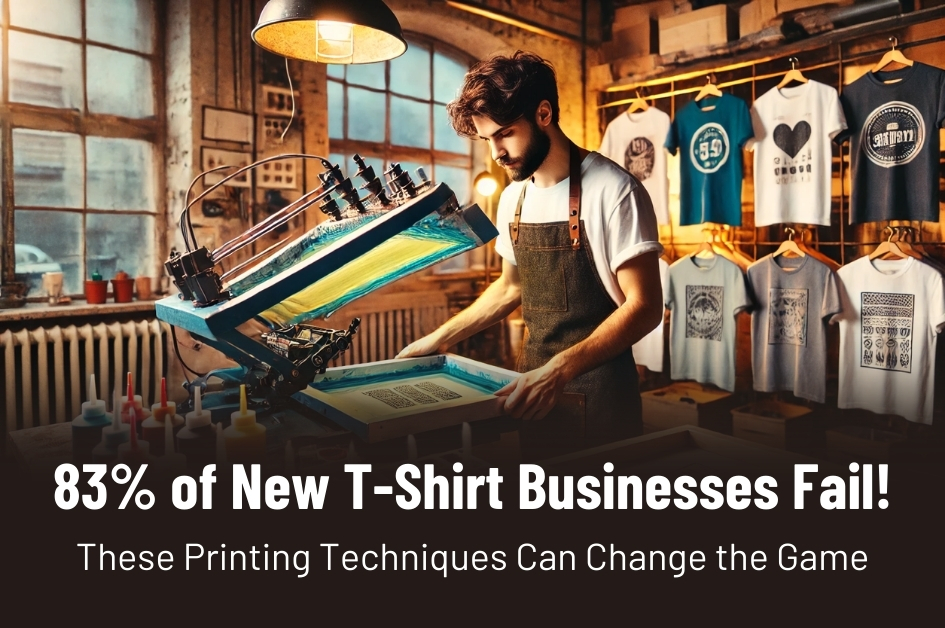Why T-Shirt Printing is Booming in 2025?
T-shirt printing has become one of the most profitable businesses worldwide. With social media trends, personalized clothing, and custom branding growing rapidly, entrepreneurs are jumping into this industry.
- The global T-shirt printing market is expected to reach $10 billion by 2025 (Source: Statista).
- Influencers and brands are fueling demand for unique, high-quality prints (Source: Forbes).
- With the right printing method, a small investment can turn into a big profit (Source: Business Insider).
But here’s the catch: If you don’t choose the right technique, your prints may fade, crack, or wear out quickly—leading to customer complaints and losses.
Want to make the right choice? Here are the best T-shirt printing methods for 2025 that guarantee high-quality prints and maximum profits!
1. What is Screen Printing and Why is it Still the King?
Screen printing is the oldest and most popular T-shirt printing method. It involves pressing ink through a stencil (screen) onto fabric.
Why is Screen Printing Still the Best?
✅ Super Durable – Can last 100+ washes without fading (Source: Printwear Magazine).
✅ Best for Bulk Orders – Costs go down as quantity increases.
✅ Vibrant Colors – Produces rich and bright prints.
Downside: High setup cost (₹50,000+) and not ideal for small batches.
💡 Best for businesses handling large orders like corporate branding and event merchandise.
2. How Does Direct-to-Garment (DTG) Printing Work?
DTG printing is like a high-tech inkjet printer that directly prints onto fabric.
Pros of DTG Printing
✅ Photorealistic Quality – Perfect for detailed images (Source: Textile Today).
✅ No Setup Cost – Great for small businesses.
✅ Eco-Friendly – Uses water-based inks.
Downside: Ink costs are high, and prints don’t last as long as screen printing.
💡 Best for custom orders and low-volume personalized T-shirts.
3. What Makes Heat Press Printing the Best for Small Businesses?
Heat press printing transfers designs onto fabric using heat and pressure.
Why Beginners Love Heat Press Printing?
✅ Low Cost to Start – ₹30,000-₹50,000 setup cost (Source: IndiaMart).
✅ Works on Any Fabric – Cotton, polyester, blends.
✅ Easy for Home-Based Businesses.
Downside: Designs may peel over time, especially after multiple washes.
💡 Great for beginners who want to print custom T-shirts from home!
4. What is Sublimation Printing and Why is It Ideal for Polyester?
Sublimation printing uses heat and special ink that turns into gas and bonds with fabric.
Advantages of Sublimation Printing
✅ Ultra-Durable – Won’t crack, peel, or fade (Source: Printful).
✅ Best for Sportswear & Polyester Fabric.
✅ Prints Full-Color, Edge-to-Edge Designs.
Downside: Works only on polyester or polyester-coated surfaces.
💡 Best for activewear, jerseys, and custom polyester apparel!
5. Is Vinyl Printing Worth It for Personalized T-Shirts?
Vinyl printing cuts designs from colored vinyl sheets and heat-presses them onto T-shirts.
Pros of Vinyl Printing
✅ Bold, Solid Colors – Great for sports jerseys and name prints.
✅ Super Durable – Lasts longer than regular heat press prints.
✅ Best for Custom Names & Numbers.
Downside: Not ideal for complex, multi-color designs (Source: T-Shirt Magazine).
💡 Best for custom orders with personalized names and numbers (sportswear, uniforms, team jerseys).
6. How Does DTF (Direct to Film) Printing Work?
DTF printing prints designs onto a special film, then transfers them to fabric.
Why DTF is a Game-Changer in 2025?
✅ Prints on Any Fabric – Cotton, polyester, blends, silk, leather.
✅ Waterproof & Stretchable Prints.
✅ Vibrant Colors & Smooth Texture.
Downside: Requires special DTF printers and films (higher initial cost).
💡 Best for businesses looking for long-lasting, full-color prints on all fabrics!
7. What is Puff Print and Why is It Trending?
Puff print creates a raised, 3D effect using special ink that expands when heated.
Why Fashion Brands Love Puff Print?
✅ Luxury Look & Feel.
✅ Unique 3D Texture – More Premium than Regular Prints.
✅ Increases Product Value & Pricing.
Downside: Not suitable for detailed designs (Source: Fashion Business Weekly)【9】.
💡 Best for streetwear brands and premium fashion collections!
Sources:
- Statista – Global T-Shirt Printing Market Growth 2025
- Forbes – The Rise of Personalized Fashion & Print-On-Demand
- Business Insider – How Entrepreneurs Are Cashing In on Custom Apparel
- Printwear Magazine – Screen Printing Durability Report
- Textile Today – DTG vs Screen Printing: Which One Wins?
- IndiaMart – Heat Press Machines Price & Suppliers in India
- Printful – What is Sublimation Printing? Pros & Cons
- T-Shirt Magazine – Vinyl Printing Techniques for Small Businesses
- Fashion Business Weekly – Emerging T-Shirt Trends for 2025
Final Thoughts: Which T-Shirt Printing Method is Best for You?
Choosing the right printing technique depends on your budget, fabric choice, and business model.
✅ Best for Beginners: Heat Press, Vinyl Printing
✅ Best for Bulk Orders: Screen Printing, Discharge Printing
✅ Best for Detailed Prints: DTG, DTF
✅ Best for Polyester: Sublimation Printing
✅ Best for Luxury Fashion: Puff Print, Foil Printing
If you’re serious about starting a successful T-shirt printing business, choosing the right technique can make all the difference.



